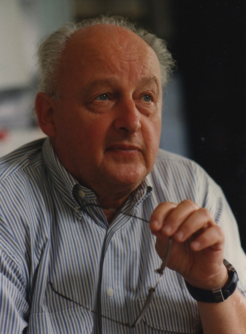Joachim Trümper named honorary member of the DPG
Because of his ground-breaking work in X-ray astronomy and efforts in promoting X-ray astronomy in Germany, especially with the X-ray satellite ROSAT, Prof. Dr. Joachim Trümper, Director Emeritus at MPE, has been named honorary member of the German Physical Society DPG. The society awards this honour to persons who have rendered outstanding services to physics or the DPG.
The aim of the German Physical Society (DPD) is to promote science in the field of physics and its sub-areas and neighbouring fields, both nationally and internationally. With some 55,000 members, DPD is the largest physics society worldwide. It grew from an initiative of six young scientists in 1845 in Berlin attending the colloquium with Professor Gustav Magnus. In addition, these young scientists wanted to discuss the latest developments in physics and, by founding a public society, to include other interested parties. On 14 January 2020, the DPG celebrated its 175th anniversary with a kick-off event in the Magnus-Haus Berlin. At the DPD spring conference (cancelled due to Covid-19) the honorary membership of Prof. Dr. Joachim Trümper, director emeritus at MPE, was to be officially announced and celebrated:
“In recognition of his achievements in the development of X-ray astronomy with balloon experiments and satellites, in particular with the X-ray satellite ROSAT, which became a milestone in high-energy astrophysics, and his ground-breaking scientific work on galactic and extragalactic X-ray sources, as well as for his merits as President of the German Physical Society. As president from 1986 to 1988, he vigorously represented the interests of basic research in a time of upheaval.”

Internationally, Joachim Trümper is regarded as one of the pioneers of X-ray astronomy. In 1971, he started with the development of detectors to observe cosmic X-ray sources from stratospheric balloons. Trümper was the initiator and scientific director of the satellite mission ROSAT, which carried out the first complete sky survey with an imaging X-ray telescope in 1990/91. ROSAT was able to boost the number of known X-ray sources from about 5000 to over 200,000. He and his group have been actively involved in the X-ray satellites Chandra by NASA and XMM-Newton by ESA, which were launched in 1999 and are still operating.
Joachim Trümper studied physics at the Universities of Halle (Saale), Hamburg and Kiel from 1952 to 1959. In 1959, he received his PhD from the University of Kiel, where he qualified as professor in 1966. From 1971 to 1975, he held the Chair of Astronomy and was Director of the Astronomical Institute of Tübingen University. From 1975 until his retirement in 2001, he was director at the Max Planck Institute for Extraterrestrial Physics (MPE) as well as honorary professor at the Ludwig Maximilian University Munich. At MPE, he is still actively engaged in research with a focus on neutron stars and other final stages of stellar evolution.
For his contributions in the field of astrophysics and astronomy, Trümper has been honoured many times. In addition to other awards, he received the Order of Merit of the Federal Republic of Germany, the Max Planck Research Prize for International Cooperation, the Bavarian Order of Merit, the Stern Gerlach Medal of the German Physical Society, the Karl Schwarzschild Medal of the German Astronomical Society, the Tycho Brahe Prize of the European Astronomical Society, and the X-ray Medal of the city of Würzburg, where Wilhelm Conrad Röntgen originally discovered X-rays. Since 1988, he is a member of the Leopoldina.
